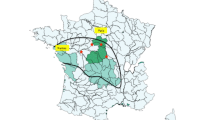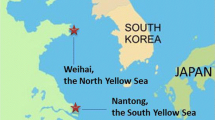Synopsis
Gas chromatography coupled with electrolytic conductivity detection and electron capture negative chemical ionization mass spectrometry have been used to identify and quantify organochlorine xenobiotics in tissues from two specimens of the living coelacanth Latimeria chalumnae. Compounds identified include polychlorinated biphenyls (PCB), 4,4′-DDT and its metabolites 4,4′-DDD and 4,4′-DDE. Levels of these compounds in the specimens were observed to be generally related to tissue lipid content. Highest concentrations of the xenobiotics were present in the lipid-rich swim bladder, followed by adipose tissue and liver. Levels ranged from 89 to 510 μg kg−1 for PCB and 210 to 840 μg kg−1 for Σ-DDT (including DDD and DDE) on a wet-weight basis. Organochlorine concentrations in relatively lipid-poor tissues, i.e. muscle and kidney, were lower. Parent DDT contributed significantly to the Σ-DDT burden. PCB congeners containing five to seven chlorines were most prevalent. Component distributions did not match those present in common commercial PCB formulations. However, major congeners observed were similar to those reported for other fishes.
Similar content being viewed by others
References cited
Barber, R.T. & S.M. Warlen. 1979. Organochlorine insecticide residues in deep sea fish from 2500 m in the Atlantic Ocean. Environ. Sci. Techol. 13: 1146–1148.
Benson, A.A. & R.F. Lee. 1975. The role of waxes in oceanic food chains. Sci. Amer. 232: 76–86.
Davies, R. & R.M. Randall. 1990. Historical and geographical patterns in eggshell thickness of African fish eagles, Haliaeetus vocifer, in relation to pesticide use within southern Africa. In: R.D. Chancellor (ed.) Proceedings Third World Conference on Birds of Prey, World Working Group on Birds of Prey. (in press.).
Duinker, J.C., D.E. Schultz & G. Petrick. 1988. Selection of chlorinated biphenyl congeners for analysis in environmental samples. Mar. Poll. Bull. 19: 19–25.
Elder, D.L. & S.W. Fowler. 1977. Polychlorinated biphenyls: penetration into the deep ocean by zooplankton. Fecal pellet transport. Science 197: 359–361.
Gregor, D.J. & W.D. Gummer. 1989. Evidence of atmospheric transport and deposition of organochlorine pesticides and polychlorinated biphenyls in Canadian Artie snow. Environ. Sci. Technol. 23: 561–565.
Hale, R.C. 1988. Disposition of polycyclic aromatic compounds in blue crabs, Callinectes sapidus, from the southern Chesapeake Bay. Estuaries 11: 255–263.
Harvey, G.R., H.P. Miklas, V.T. Bowen & W.G. Steinhauer. 1973. Observations on the distribution of chlorinated hydrocarbons in Atlantic Ocean organisms. J. Mar. Res. 32: 103–118.
Hose, J.E., J.N. Cross, S.G. Smith & D. Diehl. 1989. Reproductive impairment in a fish inhabiting a contaminated coastal environment off southern California. Environ. Poll. 57: 139–148.
Hutzinger, O.S., S. Safe & V. Zitko. 1974. The chemistry of PCBs. CRC Press, Boca Raton. 269 pp.
Kramer, W., H. Buchert, U. Reuter, M. Biscoito, D.G. Maul, G. Le Grand & K. Ballschmiter. 1984. Global baseline pollution studies IX: C6 – C14 organochlorine compounds in surfacewater and deep-sea fish from the eastern North Atlantic. Chemosphere 13: 1255–1267.
Maack, L. & W.C. Sonzogni. 1988. Analysis of polychlorobiphenyl congeners in Wisconsin fish. Arch. Environ. Contam. Toxicol. 17: 711–719.
Manchester-Neesvig, J.B. & A.W. Andren. 1989. Seasonal variation in the atmospheric concentration of polychlorinated biphenyl congeners. Environ. Sci. Technol. 23: 1138–1148.
Muir, D.C.G., R.J. Norstrom & M. Simon. 1988. Organochlorine contaminants in Arctic marine food chains: accumulation of specific polychlorinated biphenyls and chlordane-related compounds. Environ. Sci. Technol. 22: 1071–1079.
Mullin, M.D., C.M. Pochini, S. McCrindle, M. Romkes, S.H. Safe & L.M. Safe. 1984. High-resolution PCB analysis: synthesis and chromatographic properties of all 209 PCB congeners. Environ. Sci. Technol. 18: 468–476.
Musial, C.J. & J.F. Uthe. 1983. Widespread occurrence of the pesticide toxaphene in Canadian east coast marine fish. Intern. J. Environ. Anal. Chem. 14: 117–126.
National Research Council. 1979. Polychlorinated biphenyls. National Academy of Sciences, Washington D.C. 182 pp.
Niimi, A.J. & B.G. Oliver. 1983. Biological half-lives of polychlorinated biphenyl (PCB) congeners in whole fish and muscle of rainbow trout (Salm gairdneri). Can. J. Fish. Aquat. Sci. 40: 1388–1394.
Niimi, A.J. & B.G. Oliver. 1989. Distribution of polychlorinated biphenyl congeners and other halocarbons in whole fish and muscle among Lake Ontario salmonids. Environ. Sci. Technol. 23: 83–88.
Oliver, B.G. & A.J. Niimi. 1988. Trophodynamic analysis of polychlorinated biphenyl congeners and other chlorinated hydrocarbons in the Lake Ontario ecosystem. Environ. Sci. Technol. 22: 388–397.
Rapaport, R.A., N.R. Urban, P.D. Capel, J.E. Baker, B.B. Looney, S.J. Eisenreich & E. Gorham. 1985. ‘New’ DDT inputs to North America: atmospheric deposition. Chemosphere 14: 1167–1173.
Roos, A.H., P.G.M. Kienhuis, W.A. Traag & L.G.M.Th. Tuinstra. 1989. Problems encountered in the determination of 2,3,4-2′,4′,5′-hexachlorobiphenyl (CB 138) in environmental samples Intern. J. Environ. Anal. Chem. 36: 155–161.
Schneider, R. 1982. Polychlorinated biphenyls (PCBs) in cod tissues from the Western Baltic: significance of equilibrium partitioning and lipid composition in the bioaccumulation of lipophilic pollutants in gill-breathing animals. Meeresforsch. 29: 69–79.
Schulz, D.E., G. Petrick & J.C. Duinker. 1988. Chlorinated biphenyls in North Atlantic surface and deep water. Mar. Poll. Bull. 19: 526–531.
Stegeman, J.J., P.J. Kloepper-Sams & J.W. Farrington. 1986. Monooxygenase induction and chlorobiphenyls in the deepsea fish Coryphaenoides armatus. Science 231: 1287–1289.
Subramanian, B.R., S. Tanabe, H. Hidaka & R. Tatsukawa. 1983. DDTs and PCB isomers and congeners in Antarctic fish. Arch. Environ. Contam. Toxicol. 12: 621–626.
Takagi, M., H. Murayama & S. Soma. 1975. PCB contents in several species of flatfish collected in the Eastern Bering Sea. Bull. Jap. Soc. Sci. Fish. 41: 685–690.
Tanabe, S., H. Tanaka, R. Tatsukawa & I. Nakamura. 1980. Organochlorine compound residues in several species of fishes caught off Chile. Bull. Jap. Soc. Sci. Fish. 46: 763–769.
Thompson, W.R. 1983. DDT in Zimbabwe. World Working Group on Birds of Prey 1: 41–47.
Thomson, K.S. 1973. Secrets of the coelacanth. Nat. Hist. 82: 58–65.
Van der Oost, R., H. Heida & A. Opperhuizen. 1988. Polychlorinated biphenyl congeners in sediments, plankton, molluscs, crustaceans, and eel in a freshwater lake: implications of using reference chemicals and indicator organisms in bioaccumulation studies. Arch. Envir. Contam. Toxicol. 17: 721–729.
Veierov, D. & N. Aharonson. 1978. Simplified fat extraction with sulfuric acid as cleanup procedure for residue determination of chlorinated hydrocarbons in butter. J. Assoc. Off. Anal. Chem. 61: 253–260.
Zell, M. & K. Ballschmitter. 1980. Baseline studies of the global pollution. 111. Trace analysis of polychlorinated biphenyls (PCB) by ECD glass capillary gas chromatography in environmental samples of different trophic levels. Fresenius Z. Anal. Chem. 304: 337–349.
Author information
Authors and Affiliations
Rights and permissions
About this article
Cite this article
Hale, R.C., Greaves, J., Gundersen, J.L. et al. Occurrence of organochlorine contaminants in tissues of the coelacanth Latimeria chalumnae . Environ Biol Fish 32, 361–367 (1991). https://doi.org/10.1007/BF00007466
Received:
Accepted:
Issue Date:
DOI: https://doi.org/10.1007/BF00007466




